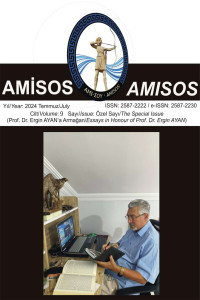Öz
I. Iustinus'un çağrısıyla başkent Constantinopolis'e gelen yeğeni I. Iustinianus, I. Iustinus tarafından
527 yılında eş imparator ilan edilmiş ve daha sonra aynı yıl tek imparator olmuştur. I. Iustinianus'un
Dönemi’nde imparatorluğun çeşitli yerlerinde yapıların onarımına öncülük etmesi, sanat ve
mimariyi desteklemesi 6. yüzyılı önemli kılmıştır. Constantinopolis'te hipodromda yapılan araba
yarışları, halkın adrenalin tutkusunu sürdürmesini sağlamıştır. Ancak bir olay sonucunda çıkan
isyan, kente ve önemli yapılara zarar vermiştir. I. Iustinianus, Nika İsyanı'nı ordu komutanı
aracılığıyla bastırarak önemli bir kıyım gerçekleştirmiştir. Bu olaylar, imparatorluğa zarar verse de
I. Iustinianus, Hagia Sophia Kilisesi'nin inşa edilmesini sağlayarak halkı inanç aracılığıyla
kazanmıştır. Anthemios ve Isidoros gibi matematikçi ve fizikçi mimarlara görev vererek Hagia
Sophia'nın yapımını başlatmıştır. I. Iustinianus Dönemi Bizans dini mimarisinde merkezi kubbe,
kilisede tek tanrılı inançlardaki evrensel hâkimiyetin simgesel önemini vurgulayarak dikkat
çekmiştir. Dolayısıyla, I. Iustinianus Dönemi Bizans mimarisi ve sanatında önemli bir dönüm
noktası olmuştur. 6. yüzyılın ilk yarısında Nika İsyanı’nın başkent mimarisinde bir dönüşüme sebep
olabileceğinin öngörülmemesi ve bir imparatorun mimari ve sanat konusunda doğrudan teşvik edici
ve destekleyici olmasıyla birlikte imparatorluk bütçesinin bir kısmının mimari ve sanat alanında
kullanılması dönemin en belirgin özelliği olmuştur. I. Iustinianus’un imparatorluğu öncesinde, I.
Iustinus Dönemi’nde tecrübe kazanmasının yanı sıra akıllı bir kadın olan eşi Theodora’nın da
desteğiyle güçlü bir politika yürütmüştür. İmparatorluk sınırları içinde birçok yapı onarımı ya da
inşasında doğrudan etkisi olan I. Iustinianus’un toplumsal hareketleri ve orduyu başarılı yönetmesi imparatorluğun en geniş sınırlarına ulaşmasını da sağlamıştır. Askeri başarısının yanı sıra özellikle
dini mimari ve sanatta attığı adımlarla toplumun desteğini almıştır.
Anahtar Kelimeler
Kaynakça
- Alchermes, J. D. 2005, “Art and Architecture in The Age of Justinian”, M. Mass içinde, Age of Justinian, Cambridge: Cambridge University Press, 343-375.
- Bardill, J. 2000, “The Church of Sts. Sergius and Bacchus in Constantinople and the Monophysite Refugees”, Dumbarton Oaks Papers, 54, 1-11.
- Daskas, B. 2015. “The Holy Apostles: Visualizing a Lost Monument, The Underwood
- Drawings, The Ground Plans. A. Friend, G. Downey, F. Gargova, & B. Daskas içinde, “The Holy Apostles Visualizing a Lost Monument”, 19-24, Washington DC: Dumbarton Oaks.
- Deichmann, F. W. 1976, “Ravenna, Haupstadt Des Spätantiken Abendlandes Kommentar, Plananhang”, Cilt I-II, Wiesbaden: Franz Steiner Verlag GMBH.
- Deliyannis, D. M. 2010, “Ravenna in Late Antiquity.” Cambridge: Cambridge University Press.
- Düzgüner, F. 2004, Iustinianus Dönemi'nde İstanbul'da Yapılar: Procopius'un Birinci Kitabının Analizi, İstanbul: Arkeoloji ve Sanat Yayınları.
THE HISTORY OF SOCIAL CONDITIONS AND THEIR IMPACT ON RELIGIOUS ARCHITECTURE DURING THE REIGN OF JUSTINIAN I
Öz
Justinian I, summoned to the capital Constantinople by his uncle Justinus I, was declared co-emperor
in the year 527 and later became the sole emperor in the same year. His leadership during the period
of Justinian I. played a crucial role in the restoration of buildings across various locations in the
empire, making the 6th century significant in terms of art and architecture. The chariot races held in
the Hippodrome in Constantinople during this time contributed to sustaining the public's adrenaline
passion. However, a rebellion that erupted as a result of an incident caused damage to the city and
important structures. Justinian I. suppressed the Nika Rebellion through the intervention of the army
commander, conducting a significant massacre. Despite the harm caused to the empire by these events,
Justinian I. won the people's favor from a religious perspective by overseeing the construction of the
Hagia Sophia Church. He initiated the construction of Hagia Sophia by assigning tasks to
mathematician and physicist architects such as Anthemios and Isidoros. Justinian I.'s reign marked a
turning point in Byzantine religious architecture with the emphasis on the central dome, symbolizing
the importance of the celestial dome in monotheistic beliefs within the church. Therefore, the era of
Justinian I. became a significant milestone in Byzantine architecture and art. The unforeseen
transformation in the capital's architecture due to the Nika Rebellion in the first half of the 6th century,
along with the direct encouragement and support of an emperor in architectural and artistic matters,
was a distinctive feature of the period. Besides gaining experience during the reign of Justinus I. before
his own rule, Justinian I., with the intelligent support of his wife Theodora, pursued a strong policy.
His effective governance of societal movements and the army within the borders of the empire directly
influenced numerous building repairs and constructions, contributing to the empire's expansion to its
widest boundaries. In addition to his military successes, he garnered support from the society,
particularly through his steps in religious architecture and art.
Anahtar Kelimeler
Justinian I Hagia Sophia The Nika Revolt Byzantium Architecture
Kaynakça
- Alchermes, J. D. 2005, “Art and Architecture in The Age of Justinian”, M. Mass içinde, Age of Justinian, Cambridge: Cambridge University Press, 343-375.
- Bardill, J. 2000, “The Church of Sts. Sergius and Bacchus in Constantinople and the Monophysite Refugees”, Dumbarton Oaks Papers, 54, 1-11.
- Daskas, B. 2015. “The Holy Apostles: Visualizing a Lost Monument, The Underwood
- Drawings, The Ground Plans. A. Friend, G. Downey, F. Gargova, & B. Daskas içinde, “The Holy Apostles Visualizing a Lost Monument”, 19-24, Washington DC: Dumbarton Oaks.
- Deichmann, F. W. 1976, “Ravenna, Haupstadt Des Spätantiken Abendlandes Kommentar, Plananhang”, Cilt I-II, Wiesbaden: Franz Steiner Verlag GMBH.
- Deliyannis, D. M. 2010, “Ravenna in Late Antiquity.” Cambridge: Cambridge University Press.
- Düzgüner, F. 2004, Iustinianus Dönemi'nde İstanbul'da Yapılar: Procopius'un Birinci Kitabının Analizi, İstanbul: Arkeoloji ve Sanat Yayınları.
Ayrıntılar
| Birincil Dil | Türkçe |
|---|---|
| Konular | Arkeoloji Bilimi |
| Bölüm | MAKALELER / ARTICLES |
| Yazarlar | |
| Yayımlanma Tarihi | 31 Temmuz 2024 |
| Gönderilme Tarihi | 6 Temmuz 2024 |
| Kabul Tarihi | 31 Temmuz 2024 |
| Yayımlandığı Sayı | Yıl 2024 Cilt: 9 Sayı: Prof. Dr. Ergin AYAN'A ARMAĞAN Özel Sayı |
Tarihi aydınlatabilmek ümidi ile...
.................AMİSOS.................


